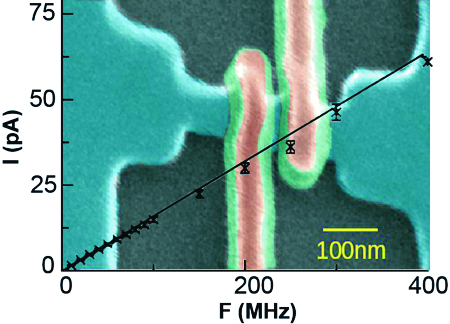The definition of the ampere in the international system of units is based on the force associated with an electrical current flowing in two parallel conductors assumed to be of infinite length. A new definition of this unit in terms of a fundamental constant, namely the elementary charge, is forthcoming.
An electron pump is a device with a series of islands which are sufficiently decoupled from each other so that their charge,
i.e. their number of individual electrons, can be controlled. Through the polarization of these Coulomb islands using control gates, single-electron transfers can be achieved. If, in addition these gates are driven with an appropriate sequence of voltages at frequency f, a single electron goes through the device at each period. The intensity of the direct current flowing through the device is thus I = e f. Frequency being a quantity that can be determined with high precision, the electron pumps are of great interest for metrology.
Current devices which are made of aluminum need to be operated at a temperature near 50 mK. Moreover, they are very fragile and limited to operation up to 50 MHz. In collaboration with Leti, we have designed an electron pump from single electron transistors made on SOI in CMOS technology. For the first time, the detection stage has been integrated into the device which, in addition, is very weakly sensitive to nearby electric charges. The measured current is proportional to the frequency up to 400 MHz. The device’s characteristics are going to be tested at metrological level.

Electron micrograph of our electron pump showing the gates (red), the spacers or barriers (green) and the nanowire (blue) as well as the source and drain.